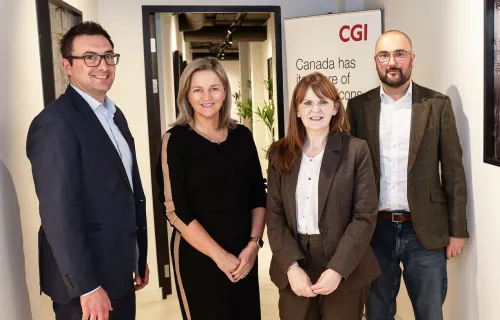Global Accessibility Awareness Day is an annual celebration that aims to get people talking and learning about digital accessibility and inclusion. Whilst it's important to reflect on the progress we've made in promoting inclusive public sector service delivery online, it's equally important to recognise the work that still needs to be done to ensure that everyone, regardless of ability, can access and benefit from digital public services.
Digital services are now essential for most of our daily tasks, from booking appointments with your GP to reporting missed bins to your local council. These services should be easy and quick to use, especially if they are your preferred way of interacting with public services. Public service organisations have a responsibility to ensure they consider a range of potential digital needs and design their services around this. This means anticipating different ways people may need to access services and making them available and accessible to all.
Every person accessing public sector services has unique needs and abilities. The best way to understand them is by talking to the people who use your product or service in a meaningful and consistent way. Doing research together with citizens is important to understand their goals and objectives, this evidence base should inform the plan, instead of just guessing and assuming based on organisational needs.
To ensure equal access to public services for all, digital accessibility is both a legal requirement and an ethical consideration. Neglecting to prioritise digital accessibility could lead to discrimination and exclusion, which undermines the principles of fairness and social justice and leaves public service organisations open to criticism and reputational damage. Ensuring equal access for all by actively removing barriers to participation should be a primary focus when promoting digital equality.
It’s especially important to achieve this for those who may face challenges when accessing multiple services at the same time due to language barriers, digital exclusion, or additional needs. We can improve accessibility by using design principles that are customer-focused and inclusive. To achieve this, we should consider how our digital services interact with each other, how we communicate and share content as well as reflecting on how we manage our own bias to promote diversity and inclusion.
How do we know we are getting it right?
Creating digital services that meet the needs of as many people as possible and are also easy to use and navigate should be part of a continuous improvement loop. How do we know that we are reducing inequalities, increasing participation, bringing citizens and our workforce with us, and ensuring that services are accessible to every citizen?
Managing change within an organisation can be a challenging task. To fully incorporate inclusive design into our processes and approach, we must ensure that everyone is on board and actively involved. From the outset, it's vital to listen to a wide range of people, testing our assumptions as we go and changing direction if these assumptions are not validated by the data. Adopting service design principles that include anyone who may be impacted by the service or product is a key activity creating an evidence base that is comprehensive and representative of diverse perspectives that should inform decisions and planning.
We must ensure that we are continuously improving the user experience with accessibility in mind, working with users as partners and embedding a culture of ongoing engagement, iterative development, and consistent measurement. This means staying engaged with users, bringing them in as partners, continuously developing, and improving the service or product, and measuring its effectiveness regularly.
In the UK, public sector websites and mobile applications are required to follow the Public Sector Bodies (Websites and Mobile Applications) Accessibility Regulations 2018. These regulations ensure that everyone, including those with disabilities, can freely access digital services if they choose to. This is particularly important since around 14 million people in the UK are estimated to have a disability. Failure to comply with these regulations can result in discrimination and exclusion for those who rely on digital services to access essential information and resources. As such, it's the responsibility of public sector organisations and their partners to design and deliver digital services that are accessible to all, regardless of ability or disability.
So how can we go about improving this picture for all users?
Getting the user journey right is essential for any web or app design. It's all about creating a quick, easy, and enjoyable experience for the user that minimises the need for them to repeat themselves. This can make a real difference to users of public sector services, giving people the freedom to access digital services and track enquiries when it suits them. As well as promoting user satisfaction, this has huge productivity benefits for organisations and resource staff, allowing them to focus on offering support in alternate ways to citizens who can’t, or won’t, engage with digital delivery.
To ensure that we are continuously improving and adapting to user needs, there are a couple of key activities that should be undertaken:
- It is imperative to incorporate citizen feedback as a crucial aspect of our strategic design process and decision making.
- We must bring the workforce with us and make sure they feel comfortable, confident, and capable of managing user expectations regardless of their chosen channel of communication.
Just like our citizens, involving the workforce in the design process will create more realistic, practical, and effective solutions and services. By assessing barriers, reluctance, and skills gaps as part of a holistic needs assessment, we can identify alternative pathways for training, development, and support. This approach creates a safe and supportive learning environment to help people embed and apply inclusive and accessible services.
Assessing our landscape through an accessible lens is part of CGI’s approach, and we know from experience that it takes a range of skills and activities to create an inclusive and diverse workplace. To ensure we can continue to learn from thought leaders in this space, we belong to The Valuable 500, an organisation that strives to drive lasting change for disabled people. Designing with disabled people in mind, CGI believes that inclusive design principles and methodologies can help break down legacy ways of thinking, driving more innovative, inclusive, and accessible design and technology. We advocate and embrace our differences within our organisation and mirror this approach with our clients through our consultancy.
Inclusion goes further than technology, working together to create and deliver public services requires a range of voices, from planning through to delivery and beyond. The process of co-producing services is based on principles of mutual respect, equal partnership, and shared responsibility. Spending time in the problem space, listening to end-users and valuing their input as collaborators results in more efficient, effective, and responsive delivery, with the aim of making the user experience and business outcomes positive for all involved.
How can CGI help you on this journey?
Starting with a clear understanding of your current position is crucial when embarking on any change initiative. Conducting an accessibility maturity assessment can provide valuable insights into an organisation's current approach to accessibility, including identifying potential challenges and areas of best practice to build on. With this knowledge, it becomes possible to set achievable and measurable goals that drive positive change and promote inclusivity in all aspects of business.
At CGI, we have a wealth of experience conducting maturity assessments across a broad range of sectors. As a trusted advisor to the organisation, we can work closely with you to review your current processes, data, and readiness for change. This enables us to provide a clear view of your current practices and a roadmap for achieving your accessibility goals. For example, we may evaluate your digital landscape, assess citizen engagement, and review how you are using technology to deliver accessible services. We can also assess the level of training and awareness around accessibility within your workforce, highlighting areas for improvement and opportunities to build resilience.
In addition, we can support you in achieving global standards for your digital products, such as WCAG 2.1 AA as well as local regulation through the delivery of recommended improvements and opportunities through assessment. With an eye on future adaptations, we can also look ahead to changes in the standards, preparing for the WCAG 2.2 update and future iterations and upgrades as they are released.
Ultimately, an accessibility maturity assessment provides a solid foundation for developing a sustainable strategy for enhancing accessibility practices and promoting inclusive delivery. By identifying gaps and opportunities for improvement, CGI can help build meaningful progress toward creating an environment that is inclusive to citizens and your organisation.






